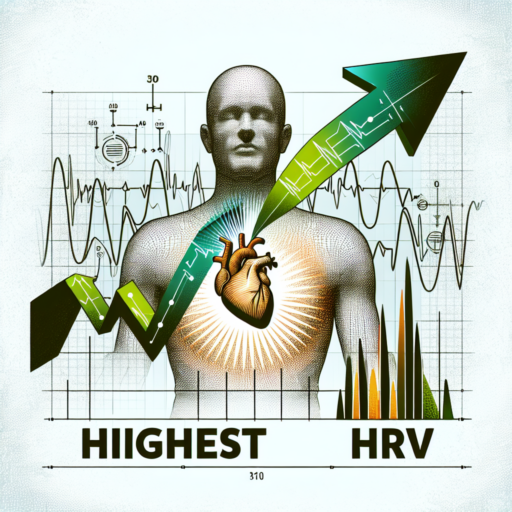What is the highest HRV?
Understanding the highest Heart Rate Variability (HRV) provides valuable insights into one’s cardiovascular and autonomic nervous system health. HRV measures the variation in time between each heartbeat and is an indicator of the balance between the sympathetic and parasympathetic nervous systems. A higher HRV signifies a healthy, responsive heart capable of adapting to stress and external demands more efficiently.
Generally, HRV scores can range significantly across individuals, influenced by factors such as age, fitness level, and daily habits. Athletes and physically active individuals often record higher HRV scores, which can exceed 100 milliseconds (ms) in peak conditions, reflecting their superior cardiovascular fitness and autonomic function. However, it’s important to note that the «highest» HRV differs from person to person based on genetic predispositions and lifestyle choices.
To accurately understand one’s HRV, consistent monitoring is recommended. Tools and devices such as heart rate monitors and smartwatches are now equipped with the capability to track HRV, providing users with data to analyze trends over time rather than focusing on single, isolated readings. These insights can guide individuals in optimizing their health and wellness strategies, tailoring exercise, and stress management techniques to improve their HRV.
Is over 200 HRV good?
When considering heart rate variability (HRV), a measurement reflecting the variation in time between successive heartbeats, a common question arises: Is an HRV over 200 considered good? Understanding HRV is crucial since it serves as an indicator of the autonomic nervous system’s balance and overall heart health.
Firstly, it’s essential to acknowledge that HRV varies widely among individuals. Factors such as age, fitness level, and stress can significantly influence one’s HRV. Generally, a higher HRV is associated with a healthier heart and cardiovascular system. Hence, an HRV over 200 can indeed be viewed positively in many contexts. This high reading suggests a strong ability of the heart to adapt to various stress levels and demands, indicating good autonomic and cardiovascular health.
However, interpreting HRV should be done cautiously. Individual differences mean that what is considered a «good» HRV can vary tremendously from one person to the next. While an HRV over 200 might be excellent for some, it’s always wise to compare it within the context of personal baselines and alongside other health indicators. Consulting with a healthcare professional can provide a more personalized understanding of what such an HRV reading means for your health.
Can HRV be over 100?
When examining the parameters of heart rate variability (HRV), many individuals question whether HRV can exceed 100. This query stems from a desire to understand the normal ranges and possible implications of variations in HRV readings. HRV, a measure of the variation in time between each heartbeat, reflects the autonomic nervous system’s regulation of the heart. It is an indicator of the balance between the sympathetic and parasympathetic nervous systems.
Indeed, HRV can surpass the 100 milliseconds (ms) mark, especially in healthy individuals. High HRV numbers are generally perceived as indicators of good heart health and a robust autonomic nervous system. Athletes and physically fit individuals, for instance, often exhibit higher HRV scores, highlighting their bodies’ efficiency in managing stress and recovery. This efficiency includes the rapid adjustment to changes in physical demands and the ability to maintain homeostasis under various conditions.
However, it’s important to contextualize HRV readings within individual health profiles. Various factors, such as age, fitness level, and presence of certain health conditions, significantly influence what an «ideal» HRV score might look like for each person. For example, younger people typically have higher HRV values compared to older individuals, reflecting the natural decline in autonomic function with age. Additionally, consistently high HRV figures, much like those exceeding 100 ms, can be indicative of a well-tuned cardiovascular system and effective stress response mechanisms.
Understanding the intricacies of HRV requires looking beyond the numbers. While a higher HRV is usually a sign of good health, interpreting these values should always be done considering the broader context of individual health status and lifestyle. This approach ensures that any intervention or lifestyle adjustment is based on a comprehensive understanding of what HRV figures signify for each unique individual.
No se han encontrado productos.
What is the maximum HRV?
Understanding the concept of Heart Rate Variability (HRV) is essential for athletes, fitness enthusiasts, and anyone interested in monitoring their heart health. HRV measures the variation in time between each heartbeat, reflecting the state of balance between the sympathetic and parasympathetic nervous systems. While discussing the maximum HRV, it’s pivotal to recognize that higher HRV values typically indicate a more balanced and resilient cardiovascular system. However, the notion of a «maximum HRV» varies significantly across individuals due to several factors including age, fitness level, and overall health.
One of the key considerations when exploring the idea of maximum HRV is its dependence on personal baselines. Generally, athletes or individuals with higher cardiovascular fitness levels tend to exhibit higher HRV scores. This is because their hearts are more efficient, able to respond and adapt to stressors more effectively. However, pinpointing a universal ‘maximum’ is challenging because what may be high for one person could be just average for another, depending on their physiological makeup and lifestyle.
In the context of measuring and interpreting HRV, it’s crucial to focus on individual trends rather than absolute numbers. Tracking changes in your HRV over time can provide insights into how your body responds to stress, recovery, and various lifestyle factors. This personalized approach underscores the importance of consistency in measurement for accurately gauging one’s cardiovascular health and fitness progress.




